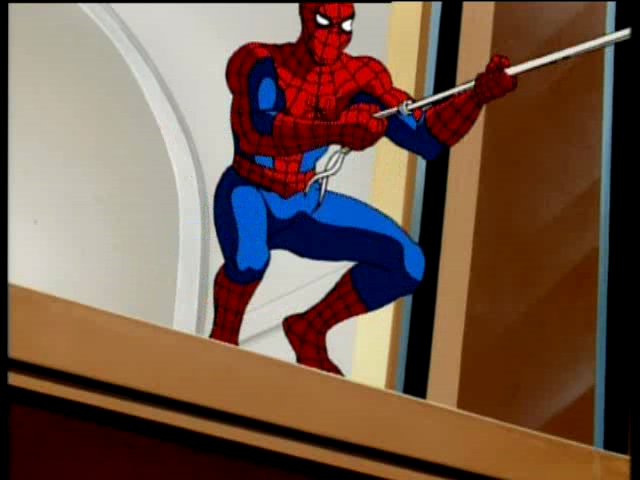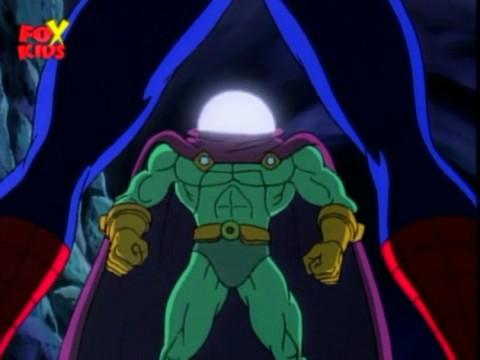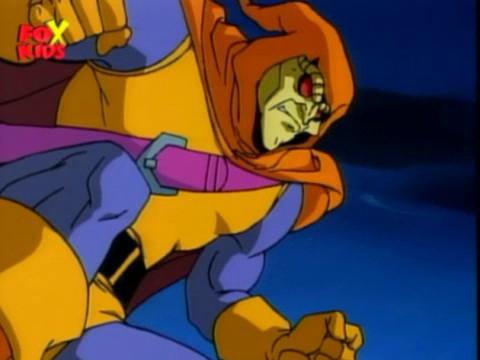Stan Berkowitz has written for several cartoons in his career. Over the past decade, he has scripted some of the greatest episodes of some of the most critically acclaimed cartoons including Superman, Batman Beyond and Static Shock. He currently serves as story editor for Cartoon Network's Justice League Unlimited The Marvel Animation Age was able to catch up with Stan for to talk about his work on Fox Kids' Spider-Man: The Animated Series.
MAA: How was writing Spider-Man: The Animated Series different from the numerous other shows you write for?
 Stan: Spider-Man was different from other shows I worked on primarily because of the birthing pains.
There were lots of people who had a say in what the show would be like, and none of them seemed to agree at the start.
A draft of a script might please one of the producers, but then the network would hate it, and vice versa. There would
be seemingly endless re-writes. Most shows have problems like this at the beginning, but this was the most extreme
instance I've seen. And it was a bit of a surprise, too, because the comic was so explicit; you'd think that everybody
would know exactly what the show should be, down to the smallest detail, based on the template that Stan Lee had laid
out years earlier in the comics. But if it hadn't been John Semper's considerable diplomatic skills, the show might
still be in pre-production.
Stan: Spider-Man was different from other shows I worked on primarily because of the birthing pains.
There were lots of people who had a say in what the show would be like, and none of them seemed to agree at the start.
A draft of a script might please one of the producers, but then the network would hate it, and vice versa. There would
be seemingly endless re-writes. Most shows have problems like this at the beginning, but this was the most extreme
instance I've seen. And it was a bit of a surprise, too, because the comic was so explicit; you'd think that everybody
would know exactly what the show should be, down to the smallest detail, based on the template that Stan Lee had laid
out years earlier in the comics. But if it hadn't been John Semper's considerable diplomatic skills, the show might
still be in pre-production.The show was very strict with its censorship rules. No punching, fire or children in peril are just a few examples of things you werenít allowed to do in the show. How did you work around that?
We had to respect the censor's rules. There was no way around them. We understood that the show's primary audience would be children, but we hoped that we could attract adults by occasionally focusing on the characters' romantic relationships.
Spider-Man was different from most Saturday morning cartoons at the time; due to its season long arcs rather than the 22-minute stand alone episodes. Do you prefer the season long arcs, or the single episodes?
As a viewer, I prefer season-long storylines because, if done properly, they illuminate character far more than stand-alone episodes. But as a writer, I prefer an anthological approach, because it allows me more freedom to experiment with tone. For example, on one anthological series, "Superman," we were able to do comedies, films noir and outright horror.
 The series was known for taking the Lee/Ditko stories of the 60ís and putting a fresh spin on them for a new audience.
How important is it to remain faithful to the source material, in your opinion?
The series was known for taking the Lee/Ditko stories of the 60ís and putting a fresh spin on them for a new audience.
How important is it to remain faithful to the source material, in your opinion?I think a show should be only as faithful to its original source as it needs to be. The Spider-Man movie was very faithful to the comic and was a tremendous success, but there have been many equally successful movies that all but ignored the source material. It all depends on the material.
The series had an especially large cast for a cartoon, Peter's classmates, The Daily Bugle crew and the super villains. Who in particular did you enjoy writing for?
The character that stood out most to me was Jameson. His hatred for Peter and Spidey was so pathological; I eventually came to the conclusion that Stan was trying to say something about anti-Semitism -- which wasn't just confined to Germany when Stan was growing up. Obviously, that's all subtext, but it explains a lot of things.
Which is your favourite of the shows 65 episodes?
 My favourite episode is the one where Spider-Man meets Stan Lee in the alternate dimension and has an adventure with him.
(I just like alternate dimension stories. Always have, ever since seeing "It's a Wonderful Life.")
My favourite episode is the one where Spider-Man meets Stan Lee in the alternate dimension and has an adventure with him.
(I just like alternate dimension stories. Always have, ever since seeing "It's a Wonderful Life.")
You wrote many episodes pivitoal to the plot in future episodes. The Spider Slayers episodes, for example introduced a lot of the key players in the show, most of whom had countless appearances, such as Norman Osborn, The Kingpin and Alister Smythe. What went into trying to introduce so many important characters in such a short amount of time?
In general, when a writer has to introduce a lot of characters in a short time, he needs to create -- and distill -- defining moments for each of the characters -- scenes that quickly tell the audience who these people are and what they want. That was the challenge on Spider Slayers, and I leave it to the viewers to decide if it was met.
The episode was also the viewers' first introduction to Felicia Hardy, one of Peters love interests. As the romantic situations where what the show used to try and attract the older audience, what thoughts went into this re-take on Felicia?
From my point of view, it wasn't a re-take; it was the first time I wrote for Felicia. It was John Semper's idea to present her as a society girl, so she would be a nice contrast to the blue collar Peter. It was also John's idea to intro Felicia before the more popular Mary Jane, a bold move in my opinion.
The Menace Of Mysterio was the first episode to retell Spider-Man's origin. I've read that this was because James Cameron was about to make 'Spider-Man: The Movie'. What other restrictions did the movie put on the show?
 I can't confirm or deny this, but what I can tell you is that Cameron's draft was different from our take; he had web
fluid oozing from Peter's wrist, while we stuck to the idea of mechanical web shooters. And as for the concept of
waiting a few episodes before doing the origin story -- another bold move, in my opinion.
I can't confirm or deny this, but what I can tell you is that Cameron's draft was different from our take; he had web
fluid oozing from Peter's wrist, while we stuck to the idea of mechanical web shooters. And as for the concept of
waiting a few episodes before doing the origin story -- another bold move, in my opinion.What process went into translating Mysterio from the comic books into the TV screens?
Uh, I don't know. You sort of read the comic and try to figure out what the guy should sound like. The adaptation process is more instinctive than analytical.
One of the parts of the show that confused a lot of the fans was that The Hobgoblin was introduced 2 seasons before The Green Goblin whereas in the comics, it was the other way around. How did you try and make sense of the situation?
It wasn't that big of a deal to me; If the original Hobgoblin was someone who found the Green Goblin's stuff, why couldn't it have happened the other way around on the show?
The Hobgoblin was one of the more intriguing characters on the show to me; due to the fact we never knew who he was for his first several appearances, until the end of season 3. Jason Macandale was also introduced early in season 3. Was this planned from the start of the series
 As far as I know, yes.
As far as I know, yes. You wrote several episodes of the first season, which generally served as introduction episodes for the villains. Who was your favourite villain to write for in the show?
Venom. I liked his sense of humour.
Speaking of Venom, apparently, it was quite an ordeal getting Venom to the TV screens, based on what John Semper has said in previous interviews. What where the main problems with adapting him?
Everybody -- producers, network, writers, artists had a different conception of the Venom story; it took a half-day-long meeting with everyone -- Avi, Stan, the network rep, the supervising producer (Bob Richardson), John and me, before a storyline could be settled upon -- and that was just for the first half hour of the three-parter.
 In fairness, I should note that it's been my experience that writing a three parter isn't three times as hard as writing a
one-parter; it's NINE times as hard. And one other thing: it's easier to get things done when you're working for one
person with bad taste than four with good taste -- although the end product probably won't be as good.
In fairness, I should note that it's been my experience that writing a three parter isn't three times as hard as writing a
one-parter; it's NINE times as hard. And one other thing: it's easier to get things done when you're working for one
person with bad taste than four with good taste -- although the end product probably won't be as good. The show took a different approach in bringing the alien costume to earth from the comic books, where Spider-Man brought it back from his trip to outer space in the popular 'Secret Wars' storyline. What thought went into having it brought to earth by the shuttle instead?
As best as I can recall, it was Avi's idea. He loved the idea of having that shuttle land on the bridge.
Venom was easily Spider-Man's most popular villain at the time this episode aired. Did this bring in any additional pressure from the network, studio etc?
If you mean network or studio pressure to use him more frequently, I don't recall any. (Am I starting to sound like Ronald Reagan yet?)
The 3 part 'Alien Costume' is widely regarded as the best the series had to offer. It took a different, darker turn to the character. How did you work around turning the shows main hero into a villain of sorts?
Who needed to work around it? I loved the idea of Peter turning into more of a badass. Traditional comic heroes can be a little too goody-two-shoes sometimes (Now I KNOW I sound like Reagan).
 When Venom returned in season 3, Carnage debuted alongside him. Due to the shows extremely strict censoring rules,
how difficult was it to translate a character that was a serial killer, without actually killing anyone?
When Venom returned in season 3, Carnage debuted alongside him. Due to the shows extremely strict censoring rules,
how difficult was it to translate a character that was a serial killer, without actually killing anyone?All we could do was hint that he was crazy and very dangerous. I think we got the point across pretty well.
The 2-part Carnage story also featured Iron Man and War Machine. At the time, Iron Man had his own syndicated animation series. Where there any limitations on how you where allowed to use them or where you allowed to use them as you like?
Obviously, we couldn't change him from the way he appeared on the other show, but aside from that, I didn't feel any other restraints.
And finally a lot of the writers of the show said it was an incredibly frustrating ordeal. What's your view on writing for the show, and the final product itself?
It was frustrating at the start because of all the re-writes we had to do, but after the first season, it got a little easier. In terms of the final product, it's always done well in the ratings; it sold a lot of toys, and it probably helped pave the way for the Spider-Man feature. What else needs to be said?
The Marvel Animation Age would like to thank Mr. Berkowitz for this interview, and the work he did on the show. Thanks Stan!